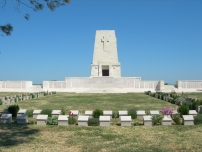| First Name: | Harry | Last Name: | SMART | |
|---|---|---|---|---|
| Date of Death: | 07/08/1915 | Lived/Born In: | Notting Hill | |
| Rank: | Private | Unit: | Australian 16Bn | |
| Memorial Site: | 1. Notting Dale, St Clement 2.Lone Pine Memorial, Gallipoli | |||
Current Information:Gallipoli 1915 On 25 April, British, Australian and New Zealand forces landed on the Gallipoli peninsula . The plan was that these forces would soon defeat a demoralised Turkish army, knock Turkey out of the war, open up the Mediterranean to the Russian navy and threaten Austro-Hungary from the south. None of these things were achieved despite nine months of hard fighting in terrible conditions. It was an heroic failure. By July, 1915, and after much fierce fighting, stalemate had set in at Gallipoli both at Cape Helles where the British and French had landed and at Anzac Cove where the Australian and New Zealand Corps were unable to break out of their beach head. Fresh troops were needed and they were on their way in the shape of four divisions from Britain and things were put on hold until they arrived. The plan for August was for a landing at Suvla Bay to the north of Anzac Cove whilst at the same time, the ANZAC Corps, reinforced by some of the new British troops would effect a breakout from Anzac Cove and establish a line across the peninsula. Whilst this was going on the troops in the south at Helles would stage a number of diversionary attacks. But it all went horribly wrong and much of the reason for this can be explained by inadequate planning and leadership. Nobody seemed to know what they were supposed to be doing and Lieutenant-General Stopford, in charge of the Suvla landings was particularly out of his depth. The landings at Suvla failed to link up with the forces at Anzac and the breakout from there did not happen despite valiant efforts by all concerned. The loss of life on all fronts was again enormous. L.A. Carlyon’s excellent book “Gallipoli” gives a superb yet chilling account of the events.
Among those units taking part in the attempt to break out of ANZAC were the New Zealand and Australian Division and it was the 4th Australian Brigade, which included the 16th Australian Battalion that, on the evening of 6th August, 1915, led the Left Assaulting Column on the long march north along the coast before turning inland to attack the heights of Sari Bair from the north and capturing Hill 971, their objective. Things did not go well for the 4th Australian Brigade. Many of them were ill, suffering from dysentery and other complaints and they were all very tired and weak after weeks and months of fighting. It was pitch dark and the terrain they had to cross was extremely difficult and confusing with deep gullies and steep ridges branching off in all directions and there were no maps to assist them nor had the ground to the north of the ANZAC beach head been reconnoitred. It was no wonder that they got lost. When the moon rose at 2.30am on 7th August they were fired on by Turkish snipers in the hills which added to the confusion and their turn to the right to approach Hill 971 was taken too early and along the wrong ridge. There was another valley to cross before they could be on the right track and launch their attack but with the men exhausted and lost, this was not going to happen on 7th August. Instead, they found what cover they could and spent the day sleeping and trying to avoid the Turkish fire. They suffered many casualties one of whom was Harry Smart of the 16th Battalion. |
||||
| « Back to Search Results | ||||
| If you think any of the information shown here is incorrect, Click Here to submit your amends and comments | ||||




